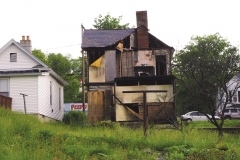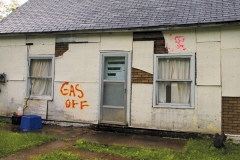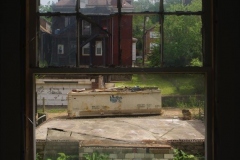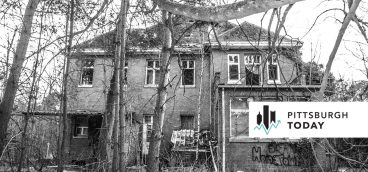The Cost of Blight
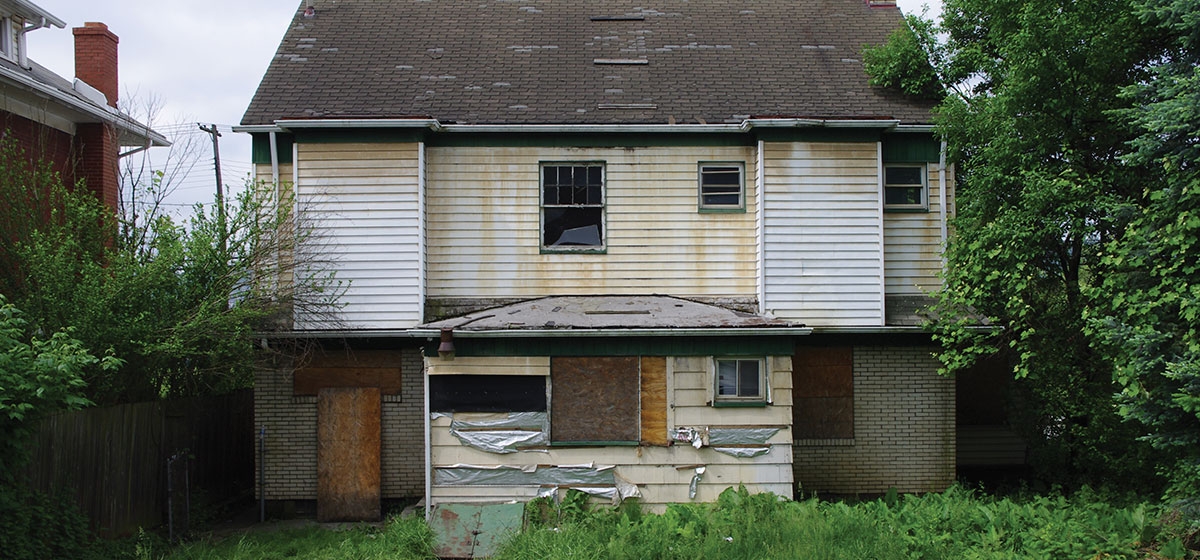
The Helen S. Faison Arts Academy, Pittsburgh’s newest elementary school, was built with the hope it would help kindle the revitalization of Homewood, which has long been one of the city’s most distressed neighborhoods.
With its modern red brick and glass facade, innovative interior design and grassy five-acre campus, it’s clearly an asset any community would be proud to call its own. At the same time, this jewel of a school stands amid what every community hopes to avoid, but what more and more are realizing is a growing problem already on their doorstep.
Directly across from the school’s Tioga Street entrance are a couple of vacant, two-story houses of aging brick. While they appear structurally sound, useless rain gutters droop from the roofs, weeds choke the yards, and first-floor windows are boarded with city-installed plywood, while the broken-out upstairs windows invite weather, birds and who-knows-what-other wildlife inside. Directly east across Dunfermline Street are empty, trash-strewn lots and the ruins of a cement block building with an uprooted toilet lying exposed in a doorway. Two blocks north, an entire block of abandoned row houses dominates Formosa Way, a grim corridor that years ago earned the reputation as one of the city’s most notorious crime havens.
Vacant property and the blight that usually follows have emerged as a crisis for cities and suburbs alike. In southwestern Pennsylvania, across the state and throughout the nation, the situation is denying local governments of desperately needed tax revenues, consuming millions of tax dollars, eroding the value of nearby homes, posing health and safety risks, and complicating already challenging neighborhood revitalization efforts.
Few communities are beset by a concentration of vacant properties as severe as that found in Homewood, where nearly 44 percent of the land parcels in the neighborhood and 30 percent of the houses are vacant, according to a study by the University of Pittsburgh Center for Urban and Social Research. But dense pockets of vacant property can be found throughout southwestern Pennsylvania and government efforts to reclaim those lots and structures fall woefully short of solving the problem.
Take Allegheny County, for example. Since 2004, the county’s Vacant Property Recovery Program has helped move some 500 vacant, tax-delinquent properties into the hands of buyers interested in turning them into side yards, small parks, and other uses that better serve their neighborhoods. But given the scale of the problem, recovering empty lots and vacant houses at that rate barely makes a dent. The county has more than 55,000 vacant houses alone, according to 2010 U.S. Census data.
“Even if we did 1,000 properties this year—and we won’t—I would have a job for life,” says Richard Ranii, who oversees the vacant property program as manager of the Housing and Human Services Division of the Allegheny County Economic Development Department.
Shifting, aging or declining population, flagging housing markets, deteriorating housing stock, crime, underperforming schools and other factors that make some communities less than desirable places to live all contribute to vacancy and blight. Recently, high mortgage foreclosure rates, unemployment, and other consequences of recession have exacerbated the problem. Most abandoned properties are tax delinquent, and the long periods of time it takes antiquated tax foreclosure systems to move against a property increases the likelihood it will be abandoned. Many properties accrue several years’ worth of back taxes and penalties. In depressed markets, such as Homewood, where the average sale price for residential property was $9,060 in 2009, it’s not unusual for back taxes and penalties to exceed the market value of a house, encouraging owners to ignore investing in its upkeep or to walk away from it entirely.
If there is a bright side to this creeping crisis, it’s the opportunity it offers to redesign certain neighborhoods in ways that are better suited to their down-sized populations, such as expanding narrow lots found in many former industrial towns to accommodate fewer, but wider and more marketable tracts, and trading abandoned lots and buildings for greenways, community gardens, recreational space and other appealing features that might help stimulate local housing markets.
“Any community that has blighted and abandoned properties and sees them only as a strain and a drain is undervaluing the real estate,” says Court Gould, executive director of Sustainable Pittsburgh, which published a comprehensive report on blight and abandonment in southwestern Pennsylvania last year. “We need to be thinking about those properties as stranded economic assets, and municipalities as having a role beyond tax collection that includes trying to figure out how to take ownership of those properties, remediate them, put them back on the tax rolls and turn them into community amenities.”
Cause for concern
It is safe to say that, at the moment, most municipalities in the region confronted with high rates of vacancy and blight are struggling to realize that silver lining. But it’s clear that more government officials, community leaders and neighborhood organizations have seen the light in terms of understanding the severity of the crisis and the need to find ways to deal with it sooner rather than later.
There are good reasons why that is happening. First, the amount of vacant property in some communities is impossible to ignore.
U.S. Census data can be imprecise, to be sure. The census counts vacant housing units, but not lots, and the data include dwellings such as apartments in between tenants and vacation property not occupied at the time of survey. But in terms of a uniform measure of vacancy in cities and towns across America, the census is it. And as rough as the measure is, the reported vacancy rates in some communities are so high that it’s hard to argue it mistakenly identifies the trouble spots.
Not surprisingly, the trouble spots include poor urban neighborhoods, older industrial areas that have experienced steady economic decline, and more recently, places stung by high rates of mortgage foreclosure. In other words, the places shouldering the biggest burden of vacant and abandoned property are usually the most economically fragile and the least likely to have the resources at hand to do something about it.
One striking example is the region’s Monongahela River valley. The collapse of the steel industry some three decades ago and the exodus that followed have littered its communities with empty houses and lots. More than 24 percent of the housing in Braddock is vacant, as is nearly 22 percent of Homestead’s, 21 percent of Duquesne’s, 20 percent of Clairton’s housing and 23 percent of Donora’s. To put the numbers in perspective, the 2010 census reports that, in the wake of the recent recession, 11 percent of the available housing throughout America stands vacant.
“There’s only so much we can do from inside the borough,” says Betty Esper, the mayor of Homestead Borough, where The Waterfront, a $300 million upscale shopping and entertainment complex built on a 260-acre brownfield site, has done little if anything to ease the borough’s high rate of vacant and blighted property. “We don’t have a lot of money. Our inspector can fine people with homes that are in disrepair. But is it too late? Is it enough? Is that going to solve our problems? I don’t know.”
With 9 percent of its available housing vacant, the seven-county Pittsburgh Metropolitan Statistical Area is below the national vacancy rate and lower than the rates of some of the older industrial areas with which it is often compared, such as the Cleveland MSA, where 10.6 percent of housing is vacant, and the Detroit MSA, which has a vacant housing rate of 10.8 percent. The rates are higher in cities. Nearly 13 percent of the housing found in Pittsburgh is vacant. But it’s easy to find nearby cities that have it worse. In Cleveland, the vacancy rate is 19 percent. In Youngstown, it’s the same. In Steubenville, Ohio, 15 percent of available housing is empty.
Anyone living in those places understands the corrosive effects that allowing houses and lots to remain vacant for years can have on the neighborhood. What is less widely recognized is that the impact of vacant and abandoned property is not confined to those streets and neighborhoods. Studies suggest that, one way or the other, almost everyone bears some degree of the economic and social costs.
Everybody pays
The precise cost that taxpayers, homeowners and municipalities pay for owning the problem in southwestern Pennsylvania has not been determined, although Pittsburgh’s Land Recycling Task Force, planning department and others are reportedly working the numbers and hope to have a more comprehensive picture of the economic impact on the city sometime this year. Despite the obvious importance of such data, most cities aren’t even that far along. “It’s a rare community that looks at its all-in costs,” says Dan Kildee, the former treasurer of Genesee County, Mich., who helped create a land-bank model that today is recognized as one of the best tools available for addressing large-scale blight and abandonment.
Philadelphia is one place that has examined those costs, and the 2010 study it commissioned offers some idea of the economic toll vacant and abandoned properties imposes on communities. The news isn’t good for property owners in the city of 1.5 million people. Vacant property reduces market values by 6.5 percent citywide and by as much as 20 percent in neighborhoods with the most empty lots and structures. The report estimates that 17,000 vacant properties are tax delinquent and rob the city of $2 million in tax revenue each year. Vacant properties also consume $20 million in city services a year, $8 million of which is spent on code enforcement and maintenance, such as boarding up buildings or demolishing them.
Among those most hurt by the damage vacant property inflicts on housing values are long-time homeowners, many of them senior citizens—the very people who tend to hold together what is left of a declining neighborhood. “We got a call last year from an elderly woman in one of those neighborhoods,” says Rob Stephany, director of the Pittsburgh Urban Redevelopment Authority. “She had a $9,000 bid from a contractor to replace her roof, which had started to leak. Her next-door neighbor’s house had sold for less than that, about $7,000. Here was a responsible, salt-of-the-earth, Greatest Generation senior citizen asking whether she should repair her roof or just ride it out. That is a loss of equity.”
The impact of vacant property extends beyond economic loss. Its role in unraveling the quality of life in a neighborhood and dimming the outlook of its residents is well documented. Nothing signals neglect and disinvestment more than a street peppered with empty, overgrown lots and abandoned houses. Not only do neighborhood residents get the message, but the larger community gets it as well. And once that happens, restoring community pride and engagement and convincing others to come in and invest becomes a much taller order.
One of the more challenging aspects of the evolving plan to take control of widespread blight in Pittsburgh’s Larimer neighborhood and turn it into gardens, green space and a down-sized but safer, more vibrant place to live, was convincing the community that it could actually be done. “It was tough getting a conversation going,” says Malik Bankston, executive director of the Kingsley Center, which built its $9 million home in Larimer to demonstrate its commitment to renewal. “For so long, the neighborhood watched a deliberate kind of disinvestment play out, which resulted in us having one of the highest incidences of vacant and blighted property.”
More than 42 percent of the lots, houses and buildings in Larimer are unoccupied. And, like most city neighborhoods with high rates of vacant and blighted property, reported crime rates are higher than citywide averages—in Larimer’s case, 30-50 percent higher.
The “broken window” theory argues that is not by coincidence. First introduced by social scientists James Q. Wilson and George Kelling in 1982, it suggests that a broken window left unrepaired leads to others being broken and sends the signal that nobody cares. Of course, it wasn’t only broken windows, but also abandoned cars, graffiti, blighted houses and other visible signs of neglect they were talking about. In such environments, the theory goes, community controls break down, leaving a neighborhood wide open to crime.
The actual relationship between vacant property and crime in southwestern Pennsylvania is unclear. Pittsburgh police, for example, don’t track that relationship. And the few studies that looked at it offer contradictory findings. But evidence elsewhere suggests the relationship is not benign. Philadelphia reports spending close to $6 million a year on police and fire calls to vacant properties. In North Carolina, a sharp rise in mortgage foreclosures and vacant houses led the Charlotte-Mecklenburg Police Department to examine its records to see whether the mortgage crisis had any bearing on crime. They found that it did. Neighborhoods with high numbers of foreclosures had higher crime rates. And violent crime, in particular, rose steadily for five years in those neighborhoods, while staying much lower in places where there were few foreclosures.
John Wallace is well acquainted with the debilitating effect vacant and blighted property can have on a neighborhood and the welfare of its residents. He’s an associate professor of social work and the Philip Halen chair in community health and social justice at the University of Pittsburgh. He grew up in Homewood and is the pastor of a church there. He has also spent the past several years planning the Homewood Children’s Village, based on a model pioneered in New York City’s Harlem neighborhood that concentrates community support and comprehensive services on mending the social fabric and improving the educational outcomes, health, and overall well-being of children who live there. Among the first orders of business in Homewood was to figure out avenues of safe passage for children – routes they can walk to get them to and from their schools without having to travel mean streets of empty lots and abandoned buildings.
“From the perspective of the Homewood Children’s Village,” he says, “the impact of vacant and abandoned properties on kids is a real concern. These properties are risk factors for crime, they’re a safety risk, and they’re a health risk.”
To what degree does vacant property contribute to a neighborhood’s downfall? Is it the cause or the consequence of problems like high crime rates that plague distressed neighborhoods and push others down the path of decline? All are interesting questions without definitive answers. But when restoring a neighborhood to health is the goal, the question that matters is whether vacant and blighted property is recognized as something that must be dealt with in order to succeed. Neighborhood revitalization, like a jigsaw puzzle, comes down to a complicated exercise of fitting all of the pieces together.
“Don’t think of it as a linear process—that if we do this, this will happen,” says Sabina Deitrick, co-director of the Urban and Regional Analysis Program at the University of Pittsburgh’s University Center for Social and Urban Research. “It’s not going to be that way. Things have to happen simultaneously.”
Liabilities to assets
The flip side of vacant and blighted properties is that under the right circumstances they can actually be used to advance the renewal of the neighborhoods to whose decline they contributed. In southwestern Pennsylvania, both public and private sector interest is growing in reclaiming vacant property to add elbow room and a little green to crowded urban neighborhoods.
“With a lot of liabilities, your only option is to eliminate or reduce them. To be able to turn a liability into a asset is a unique opportunity,” says Frederick Thieman, executive director of the Buhl Foundation, which funded the Sustainable Pittsburgh analysis of vacant and blighted property in southwestern Pennsylvania. “Vacant property provides us with such an opportunity.”
Many of the most promising efforts in the region to seize those opportunities are found in Pittsburgh. The city itself takes control of some 300 vacant, tax-delinquent properties each year through treasurer’s sales and bears the burden and cost of clearing the titles before selling the parcels at a reasonable price to residents, community development corporations, and others with bona fide plans for turning them into neighborhood assets. Its year-old Land Recycling Task Force is investigating ways to tackle vacancy and blight on a larger scale. And one program, Green Up Pittsburgh, has helped community groups and residents turn hundreds of empty lots into neighborhood green spaces and side yards.
If plans for the redevelopment of Larimer are realized, the neighborhood will be reborn as a green community, and the vacant properties that have blighted its streets for so long will have played an important role. This “greening” began with a few small-scale projects on vacant lots that introduced ideas such as community gardens and urban farming and has since become part of how residents envision their neighborhood in the future.
The idea of greening vacant property, which is gaining traction in troubled housing markets across the country, is about more than improving aesthetics. Researchers at the Wharton School of the University of Pennsylvania, for instance, report that housing values surrounding empty lots turned into gardens, parks or other green amenities rise by as much as 30 percent.
A key part of the Larimer plan is to reclaim its western border as open green space for athletic fields, hiking and bike trails, and acres of park—something that is considered possible only because of the neighborhood’s high rate of vacant property. All but a few hundred of the 2,000 or more houses that once stood on the site are vacant or have been reduced to empty lots. “The level of disruption is far less,” says Bankston. “So when we are having this conversation and only have to account for 238 occupied units, it’s something we can get our arms around.”
In Homewood, the two empty houses across from the Faison elementary school are among the properties that a nonprofit, Operation Better Block, hopes to rehabilitate with the help of the Urban Redevelopment Authority and others. It’s one of the ways that a collection of stakeholders is attempting to jump-start the dysfunctional housing market and raise the quality of life there. Successes include the Homewood Children’s Village and housing initiatives, such as 10 homes built by the nonprofit Building United of Southwestern Pennsylvania.The new homes have transformed the once-blighted block behind the Faison school and the organization has plans to build more.
That is how the war against vacant and blighted property is being waged in southwestern Pennsylvania at the moment. It’s a process driven by neighborhoods and municipalities with the ideas and the will to see them through. City and county government may offer some degree of technical support to those who ask for it, most often legal and financial help to gain control of vacant properties. But there is no comprehensive strategy at the regional, county or city level for dealing with the more than 100,000 vacant structures and lots in southwestern Pennsylvania.
One of the most ambitious homegrown approaches is found in Pittsburgh’s East Liberty neighborhood, where the local community development corporation has bought nearly all of the vacant property as part of a strategy to eliminate blight and restore stability and confidence to the real estate market. The idea to do so was the result of a lesson learned early in its decade-long campaign, which eventually brought a business corridor rejuvenated with the likes of Trader Joe’s and Target, upgraded housing stock, and rising property values to the neighborhood.
In 2001, East Liberty Development, Inc. built 10 three-bedroom houses on Mellon Street, each featuring a bath and a half and two-car garage. It priced them at $105,000. To sweeten the deal, it threw in $35,000–$40,000 deferred second mortgages at zero percent interest for income-qualified buyers. Not a single house sold.
The reason quickly became clear. A handful of rundown, abandoned buildings across the street were scaring away prospective buyers. “Nobody was willing to buy on that block until we were able to tell them a good story, something concrete, about what was going to come about across the street,” says Kendall Pelling, East Liberty Development, Inc. project manager. The community development corporation bought the abandoned properties, all of which were tax delinquent, through city treasurer’s sales and came up with a plan to renovate the empty buildings or tear them down and build new ones. And that did the trick. “As soon as we had site control of those properties, each of the houses sold, one right after the other, in very short order.”
As Pennsylvania policymakers become more aware of the risks of allowing vacant property to spread unabated, better legal tools to combat them are emerging. One hedge against long-standing blight and land speculators who tend to perpetuate the problem is the state’s recent conservatorship act. Under that law, municipalities, nonprofits and even neighbors can ask the court to appoint a third-party to rehabilitate or demolish a building when an owner refuses to do so or disappears. Once the job is done, the building is offered back to the owner for a price that covers the cost of the work or it is sold under court supervision to someone else.
But the best practice for tackling vacant property on a large scale is not available to Pennsylvania municipalities. Creating and sufficiently empowering a land bank, such as those that helped Genesee County, Mich. and Cleveland deal with their crises, requires special legislation and property tax reform, both of which are still being discussed in Harrisburg.
Banking against speculators
The Michigan land bank was largely a response to a steep and sudden drop in the population of Genesee County’s chief city, Flint. The loss of some 60,000 General Motors jobs beginning in the 1970s ultimately led to fewer than 112,000 people living within the city limits in 2005—a 43 percent decline from 1960, when Flint’s population peaked. Vacant property became a chronic citywide problem that the county tax foreclosure process was not up to solving and, in some cases, exacerbated by taking up to seven years to complete. Properties sat vacant. Market values fell. Speculators swooped in. More and more properties went through tax foreclosure, were bought and sold at auction, but rarely improved as they passed from one owner to another.
“Speculators prefer competitive auctions because for the most part they don’t think of the property as real estate. It’s just a piece of paper with a dollar amount attached to it,” says Kildee, who left Genesee County government to launch the Center for Community Progress, a nonprofit that provides technical assistance on vacant and abandoned lot issues. “They can buy a property at a deep discount at a tax sale without ever seeing it, flip it to someone else at a marginal profit and then it’s not their problem anymore. We know those systems have failed. We’ve had a half of a century experience with them, and all you have to do is to go to Flint or Cleveland or Gary, Ind. to see how that process has worked.”
Kildee needed a better way to take control of vacant property before it fell prey to land speculators and blight. He found it in a land-bank model that new laws and property tax reforms in Michigan made possible. The land bank allowed the county to more quickly take control of a delinquent property through tax foreclosure and made sure it was reused in a way that advances community improvement strategies, rather than selling it off at auction to the highest bidder, who may not have the community’s best interests in mind. Once the land bank takes a property, it can rehab, sell, rent or demolish it. Programs were put in place to help homeowners avoid tax foreclosure, and the land bank adopted a brownfield redevelopment plan for all of the nearly 4,000 tax-foreclosed properties under its control.
These land banks not only take control of tax-delinquent properties, but the revenues they generate as well. One of the hidden truths about tax delinquency is that most owners find a way to pay back taxes and penalties after they are threatened with foreclosure. By collecting interest penalties and principal from delinquent owners, land banks are able to recover a sizable portion, if not all, of the costs of maintaining, demolishing, rehabbing and marketing properties in their inventories. In Cleveland’s case, the land bank brings in $6 million to $8 million a year.
Land bank legislation came close to becoming law in Pennsylvania last year when the session ended before a bill that by all accounts had bipartisan support could finish working its way through the General Assembly. Both land banking and property tax reforms are being taken up again this year.
Whether land banking would be widely embraced in southwestern Pennsylvania is unclear. Pittsburgh Mayor Luke Ravenstahl, for one, has endorsed the pending legislation. The city takes tax-delinquent property through its treasurer’s sale process and holds parcels for community development corporations and other organizations in its land reserve. But financial constraints limit it to taking only vacant properties that have a buyer, and constraints also cap acquisitions at 300 properties a year. What the city wants more than anything is a better, sustainable financing mechanism that would allow it to take a larger share of the 6,000 vacant buildings and 14,000 empty lots found in its neighborhoods, and more quickly and cheaply put them in the hands of community groups, public and private developers, and others interested in turning them into assets. The benefits of a land bank could be even greater outside of Pittsburgh, where the capacity of most counties and municipalities to take control of vacant and blighted property is much more limited.
One issue that already makes municipalities nervous when conversations turn to land banks is start-up costs. A land bank in Pittsburgh that would automatically take all property that is tax delinquent for five years could cost $3.7 million a year to run. But the cost of clearing the titles of the more than 8,000 properties in the city’s inventory could reach $15 million, according to preliminary estimates contained in an unpublished report prepared for the Land Recycling Task Force.
Although some of those costs could be recovered later, the idea of spending that kind of money gives many municipal officials pause, as the depth of the financial crises they face in the wake of recession are becoming clear. “We run into that all of the time,” says Genesee County’s Kildee. “But it ignores the costs taxpayers already pay for vacant property and abandonment. We pay a price every time the fire department is called, and every time the tax assessor devalues surrounding properties and takes tax revenues off the tax rolls. You have to measure the cost of change against the cost of the current path that we’re on. And anybody who argues that the current path we’re on is the right one isn’t examining the full cost of vacant and abandoned property.”


